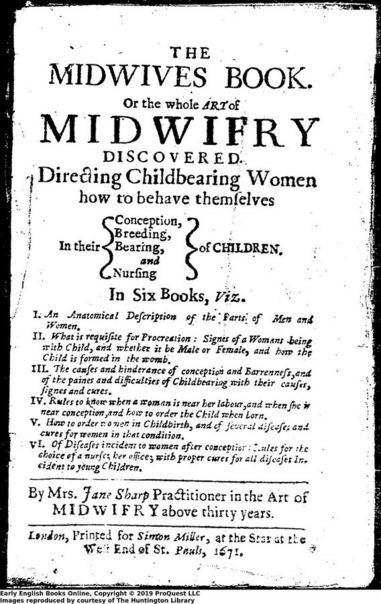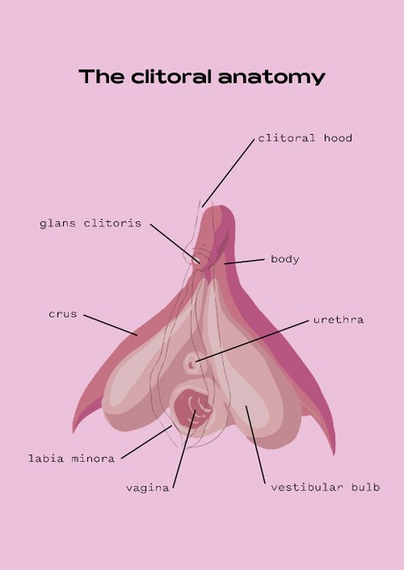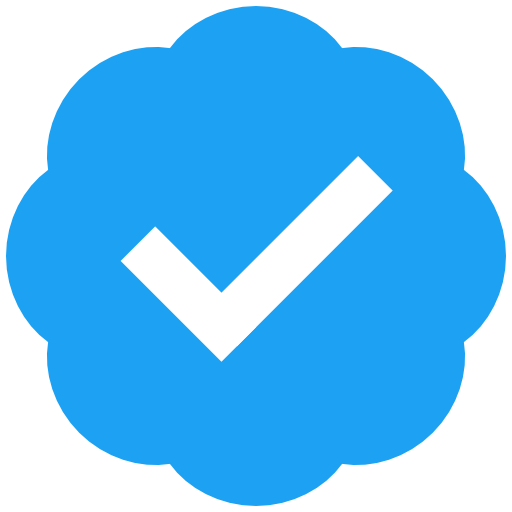Recent searches
Search options
OLD THREAD REPOST
The first detailed anatomical description of the internal clitoris was published in 1998. But in 1671, there was one author who was determined to tell the world that the clitoris had two spongy bulbs in addition to the glans, which became erect during sexual arousal.
Meet Jane Sharp. We can't show you a picture of her because very little is known about her life, aside from the fact she was an experienced midwife who published a textbook. This is its cover.
Sharp's book was a textbook for midwives, covering anatomy, sex, pregnancy, gynaecological health and knowledge to treat complications during pregnancy, childbirth and gynaecological illnesses. Her section on anatomy thoroughly details internal and external anatomy.
She begins her description of the clitoris by explaining it "will stand and fall as the Yard [penis] doth, and makes women lustfull and delight in Copulation, and if it were not for this they would have no desire nor delight, nor would they ever conceive".
Sharp believed that orgasm from both parties was essential to conception, which is unfortunately untrue.
Sharp then goes on to comment that the similarities between penis and clitoris meant that "hermaphrodites" were "only women that have their Clitoris greater and hanging out more than others have". This shows an understanding of some natural intersex variations, albeit through 17th century language.
She describes the position of the glans of the clitoris as "in the top of the greater slit where the wings end" and remarks that it is similar to a penis but lacking "the common pipe", by which she meant the urethra passing through it.
Sharp's word for the glans of the clitoris, by the way, was "Tentigo", which is an absolutely lovely word, meaning tumescence of a penis.
"Commonly it is but a small sprout, lying close hid between the Wings [labia]... yet sometimes it grows so long that it hangs forth at the slit like a Yard and will swell and stand stiff if provoked," said Sharp of the glans.
But what about the internal clitoris? According to Sharp, "it hath two sinewy bodies round, without thick and hard, but inwardly spongy and full of holes, or pores, that when the spirits come into it, it may stretch, and when the spirits are dissipated, it grows loose again." This is a remarkably accurate description of the spongy erectile tissue of the clitoral bulbs, as well as the observation that there is discernible engorgement of the area during sexual arousal.
Sharp was also aware that the bulbs of the clitoris had a relationship with the glans, saying "they part at first, but join about the join of the share bones [pubic symphysis], and so they make a solid hard body of the Yard."
If we look at a diagram of the clitoris, we can see the strength of Jane Sharp's grasp of the anatomy with the spongy bulbs meeting above the urethra with the body of the clitoris, and the glans at the top resembling the head of the penis.
Because next to nothing is known about Jane Sharp, it's impossible to say whether she applied her detailed knowledge of the clitoris to her personal life.
@vagina_museum I just laughed loud enough that my partner poked his head in where I am working to ask WTH I was doing. That toot is a thing of beauty. (Also, I sincerely hope she did.)
@jnyrose @vagina_museum Sounds like someone needs to learn how to behave themſelves!
@vagina_museum
Do know if Sharp's book had much to say on abortion?
@GreenFire This is a good question. Sharp used the word "abortion" to mean miscarriages - in present-day English, we usually differentiate induced abortion and spontaneous abortion by calling the latter "miscarriage" - and talked about pregnancy loss, how to treat and prevent it.
Like many other authors of her time, she didn't address how to induce abortion, but did include recipes for inducing menstruation when periods have stopped, which contained herbs with abortifacient qualities.
@vagina_museum
Yeah, good description of the morays (sp?) of the times.
I ask because I think our tenth amendment provides protection to women for the right to choose their own healthcare since it was common law when the constitution was ratified, but I don't have standing to make my case.
@GreenFire @vagina_museum mores, sometimes morés.
In the sixties in Ireland, my mother had a miscarriage and a doctor said not to come back until after she was three months pregnant next time because she might be a "serial aborter" and if so it would be a waste of time.
@vagina_museum random etymology thought: did "yard" as a slang term for penis come from the male habit of exaggerating their length when asked?
@siderea @forestpines @vagina_museum Yard is the word I'm now using, forever. #sailor
Which is not to say there is not a length pun involved. I believe at this time a yard also referred to a tailor's measure. I'm at work, will look into it later.
Okay, I'm back. Yes, a yard can also refer to a yardstick at this time. The Jane Sharp text we're discussing is from 1671, and the OED tells me that in the 1674 translation of T. Boccalini's _Ragguagli di Parnasso_ by the Earl of Monmouth appears the sentence, "He had a very just yard at home", which the dictionary promises us refers to the measuring-device sense.
About 40 years later – so not certain how pertinent this is to something in 1671 – there appears in the 1707 edition of _Pills to Purge Melancholy_ the innuendo-filled song "My Thing Is My Own", which has the line:
"A fine dapper Taylor, with a Yard in his Hand"
which ABSOLUTELY means EXACTLY what you think it does. It continues:
"Did proffer his Service to be at Command,
He talked of a slit I had above Knee,
But I’ll have no Tailors to stitch it for me."
(The entire thing is like that.)
BUT!...
The OED also confesses – buried deep as definition 11 under noun 2 – that "yard" just straight-up (*coff*) is an old word for phallus, going back to 1379. They quote a manuscript designated MS Gloucester Cathedral 19 No. 1. i. iii. which on the fifth pages says "[The urine] passith out by the ȝerde."
Which does not seem to be any sort of double entendre at all, but just simple discussion of anatomy, as Jane Sharp does centuries later.
@vagina_museum
unfortunately
@vagina_museum I am absolutely delighted by her use of curly brackets in the subtitle!
What a fantastic and unashamed piece of writing on the clitoris. Shame we don't know more about her; she seems cool.
@vagina_museum this is an excellent read for owners and appreciators of vaginas. Especially the non owners who would like to understand them better!
Before I get into the business of reading this thread, I would like to point out that in reading the author’s bulleted goals on the cover, it seems the GOP doesn’t want to take women back to the Victorian age, but all the way back to the 17th Century.
@vagina_museum
I love me some nurfing.
(wtf?)
@vagina_museum how to behave themſelves




